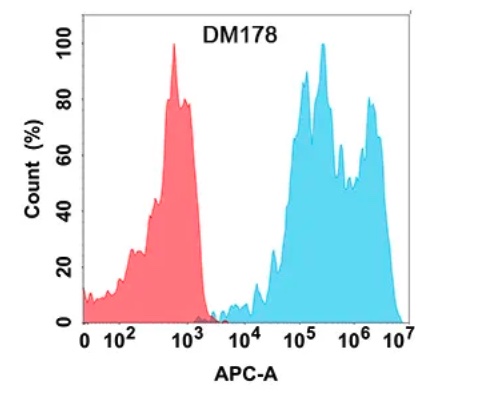Human PDGFRa / CD140a Recombinant Protein (Fc Tag)(Discontinued)
Shipping Info:
For estimated delivery dates, please contact us at [email protected]
| Amount : | 100 µg |
| Purification : | > 90 % as determined by SDS-PAGE |
| Content : | Formulation Lyophilized from sterile PBS, pH 7.4 Normally 5 % - 8 % trehalose, mannitol and 0.01% Tween80 are added as protectants before lyophilization. |
| Storage condition : | Store it under sterile conditions at -20°C to -80°C. It is recommended that the protein be aliquoted for optimal storage. Avoid repeated freeze-thaw cycles. |
| AA sequence : | Met1-Glu524 |
| Alternative Name : | CD140A Protein, PDGFR-2 Protein, PDGFR2 Protein, RHEPDGFRA Protein, |
Source : HEK293 Cells
PDGFRA, also known as CD14a, together with the structurally homolog protein PDGFRB (CD14b), are cell surface receptors for members of the platelet-derived growth factor family. They are members of the class III subfamily of receptor tyrosine kinase (RTKs) with the similar structure characteristics of five immunoglobulin-like domains in their extracellular region and a split kinase domain in their intracellular region. PDGFRA is expressed in oligodendrocyte progenitor cells and mesothelial cell, and binds all three ligand isoforms PDGF-AA, PDGF-BB and PDGF-AB with high affinity, whereas PDGFRB dose not bind PDGF-AA. PDGFRA plays an essential role in regulating proliferation, chemotaxis and migration of mesangial cells. Recent studies have indicated that PDGFRA acts as a critical mediator of signaling in testis organogenesis and Leydig cell differentiation, and in addition, particularly important for kidney development. Additionally, PDGFRA is involved in tumor angiogenesis and maintenance of the tumor microenvironment and has been implicated in development and metastasis of Hepatocellular carcinoma (HCC). PDGFRA may represent a potential therapeutic target in thymic tumours. PDGFRA gene amplification rather than gene mutation may be the underlying genetic mechanism driving PDGFRA overexpression in a portion of gliomas. Cancer Immunotherapy Immune Checkpoint Immunotherapy Targeted Therapy
PDGFRA, also known as CD14a, together with the structurally homolog protein PDGFRB (CD14b), are cell surface receptors for members of the platelet-derived growth factor family. They are members of the class III subfamily of receptor tyrosine kinase (RTKs) with the similar structure characteristics of five immunoglobulin-like domains in their extracellular region and a split kinase domain in their intracellular region. PDGFRA is expressed in oligodendrocyte progenitor cells and mesothelial cell, and binds all three ligand isoforms PDGF-AA, PDGF-BB and PDGF-AB with high affinity, whereas PDGFRB dose not bind PDGF-AA. PDGFRA plays an essential role in regulating proliferation, chemotaxis and migration of mesangial cells. Recent studies have indicated that PDGFRA acts as a critical mediator of signaling in testis organogenesis and Leydig cell differentiation, and in addition, particularly important for kidney development. Additionally, PDGFRA is involved in tumor angiogenesis and maintenance of the tumor microenvironment and has been implicated in development and metastasis of Hepatocellular carcinoma (HCC). PDGFRA may represent a potential therapeutic target in thymic tumours. PDGFRA gene amplification rather than gene mutation may be the underlying genetic mechanism driving PDGFRA overexpression in a portion of gliomas. Cancer Immunotherapy Immune Checkpoint Immunotherapy Targeted Therapy
1. Measured by its ability to bind human PDGF-C in a functional ELISA. 2. Measured by its ability to bind mouse PDGF-C in a functional ELISA.
Endotoxin :< 1.0 EU per µg of the protein as determined by the LAL method
For Research Use Only. Not for use in diagnostic/therapeutics procedures.
|
There are currently no product reviews
|






















.png)









